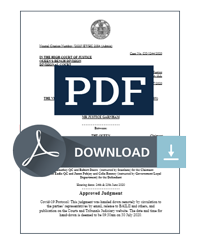The Aims of Sentencing – Preventing Re-Offending?
This article reviews the recent research report published by the Sentencing Council examining the effectiveness of sentencing with a view to approaches to mitigation. The report concluded that the evidence does not support a conclusion that more severe sentences have a significant deterrent effect on the offender or on offending behaviour generally.
Measuring the effectiveness of sentencing is a key part of the role of the Sentencing Council. On the 30th September 2022 a report was published authored by Dr Jay Gormley and Dr Ian Belton entitled “The Effectiveness of Sentencing Options on Reoffending”. The following appears in the key findings section of the report:
The evidence does not suggest that using more severe sentences (particularly sentences of immediate imprisonment over other disposals) has significant deterrent effects on the person sentenced or the general population. However, more evidence is needed to assess the deterrent effects of suspended custodial sentences, rather than immediate imprisonment, on those subject to such an order.
The report also finds that the evidence demonstrates – in fact ‘strongly suggests’ – that sentences of immediate custody under twelve months are less effective than other types of sentence when focusing on preventing reoffending. The authors state in that context that there is a ‘reasonable body’ of evidence which indicates that use of short sentences can in fact increase reoffending. An understanding of these findings may assist those presenting submissions as to sentence in certain cases.
The use of sentencing guidelines when mitigating in circumstances where it is clear what category a case will fall into, either by agreement or by direction from the bench during submissions, can often place a case into the significant bracket where – once an appropriate reduction for plea and for mitigation are taken into account – the question of whether a sentence can properly be suspended is a key consideration for the court. Reference to the guideline on use of suspended sentences and the significant authority of Petherick [2012] EWCA Crim 2214 assists those mitigating in making targeted submissions to seek to persuade the court to an option that does not involve immediate custody. Considering the import of aspects of this report in a measured way, focused as it is on the effectiveness of sentences, could well assist those tasked with inviting the court to avoid a prison sentence.
Further, depending on the facts of the case and the circumstances of the offender, the advocate may also draw assistance from some of the specifics within the report – for example when representing females (see part 7). For children, the focus on age and brain maturity (see part 3) are areas that could be drawn together with the overarching principles when sentencing young offenders to highlight pertinent features.
The aims of sentencing are enshrined in section 57 of the Sentencing Code for adults (offender aged 18 or over when convicted). Entitled “purposes of sentencing”, s57(2) states that, save in relation to disposals under the Mental Health Act 1983 or mandatory sentences, the court must have regard to:
(a) the punishment of offenders,
(b) the reduction of crime (including its reduction by deterrence),
(c) the reform and rehabilitation of offenders,
(d) the protection of the public, and
(e) the making of reparation by offenders to persons affected by their offences
For children – those under 18 – section 58 reiterates that nothing in the code affects the duty of the court to have regard to the welfare of the child and the principle aim of the Youth Justice System: preventing offending or re-offending. For adults one of the aims the court must have regard to is deterrence and reduction in crime – so implicitly reduction in re-offending; for children it is the duty of the court to have regard to preventing re-offending.
It is striking that the research does not find support on the current evidence that sentences of immediate custody – as opposed to other alternative disposals, specifically suspended sentence orders or in the case of children intensive rehabilitation orders – have a deterrent effect on the person being sentenced or the ‘general population’. When mitigating in a situation where there is a genuine question for the court as to whether imposing immediate custody in the form of imprisonment, detention in a young offender’s institution or, for those under 18, a detention and training order, an awareness of these findings could be usefully woven into submissions. In combination with a thoughtful pre-sentence report setting out a programme for sentence specifically targeting the prevention further offending acknowledging these findings might assist in what can often be a delicate balancing exercise for the court.
Marie Spenwyn
November 2022


